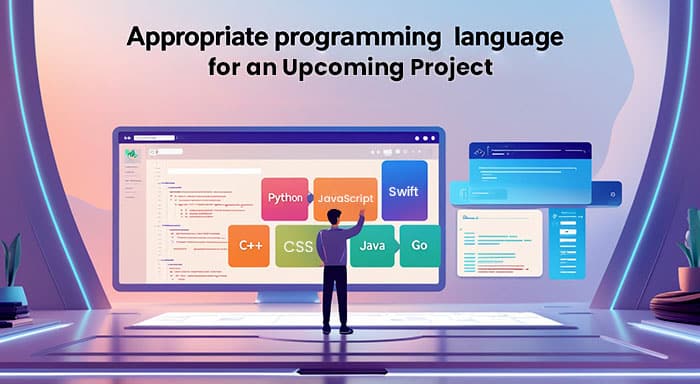Every time a developer starts a new project, they hear this question. In most cases, clients are looking for a silver bullet—a way to magically determine which language would be the most effective in turning their development initiatives into a reality.
The research should be well-founded because the project’s success heavily depends on the right combination of tools, programming languages, and libraries. It is not as simple as choosing a side and observing it, however.
Before selecting an appropriate programming language for a project—several factors need to be considered. Although experienced developers generally have a toolkit full of languages and technologies they like for certain sorts of projects, they first consider the particular nature of the project and ask many questions before deciding on one.
The success of the project and the firm depends much on the programming language chosen, as every language has advantages and drawbacks. Furthermore, influencing this decision will be the general goals and long-term ambitions of a corporation.
Also Read: Timeless Tips to Boost Software Development Speed
Criteria for Choosing a Programming Language
To clear up any uncertainty and narrow down the options, development teams ask a lot of questions about the forthcoming development project and the capabilities, constraints, and needs of the accessible programming languages.
Below are some crucial frequently asked enquiries:
- Does the project need to run on a mobile, web, or enterprise-level system?
- Is there a preference on the part of the client based on past work?
- Is the language one that the development team can effectively use? Will the learning curve be required or manageable? Would this require more developers to be brought in?
- Does the performance affect the success of projects? Will this language help achieve the expected results?
- Is the language robust enough to sustain its ecosystem over time? How long will it be before it needs updating?
- Is language assistance offered by the vendor? Does the project take into account any current or previous codebases?
- Is there any online platform available where developers can get help and advice?
- Does the language support other programs?
- In what ways is the safety of the language taken into account?
Although this is not an exhaustive list of questions designed for quick decision-making, these questions assist developers in eliminating languages that are completely inappropriate for the project.
Additionally, developers can find generic lists of "best fits" for various project types to aid in their selection process. The list might help developers if they are looking for ideas on how to kickstart a new project—but remember it is not the only place to start.
- Mobile Applications: JavaScript, Java, Swift, Object-C
- Web Applications: TypeScript, HTML, CSS, Ruby, PHP, and JavaScript
- Enterprise Applications: C++, Erlang, C#, Java
- Machine Python, R, Java, and C# for Data Visualization and Learning
- Big Data: Python, Java, R, Scala
- Data Storage: SQL, Python, Java, C#
- Operating Systems: C and C++
- Distributed Systems: Go.
Program Language Decision-Making Criteria
Type of Application
The languages that are accessible to pick from are greatly impacted by the kind of application, which might range from web and mobile platforms to corporate software. Looking at programming languages ratings, general-purpose languages like Java, Python, and JavaScript generally rule the charts as they can be utilized to produce a great range of software solutions. But certain languages are extremely specialized in the kinds of projects they best serve, so when deciding which language to utilize, one should take particular use cases and corporate demands into account.
Efficiency and scalability
A program's speed is heavily dependent on the languages it is written in, even though the technological stack has a greater impact on scalability.
Expertise in Prior Development
As they go in their professions, developers often come across several kinds of projects and use multiple languages. Before selecting the right language for a new project, the development team should discuss their experience with each other.
Security
The security needs of each application are unique. Some apps adhere to more specific security standards, while others must adhere to more broad laws or regulations (such as HIPAA compliance).
Tempo of Development
When deciding on a programming language, many individuals disregard the amount of time needed to produce code. But if you need a fast time-to-market or an accelerated schedule for your project, it's essential.
Speed of Execution
The demands of the customer or end-users are usually the most important factors in this. Customers may or may not have a large amount of data that needs processing; some may place a premium on speed, while others are constrained by the processing requirements of third-party applications. To save development time, later on, the team may figure out this requirement ahead of time.
Maintainability
There is a library system and, happily, vendor support that comes with every technology stack and language. When deciding what to support and keep up-to-date for the long term, developers should consider the language's release frequency.
In the lead-up to a new project, development teams should consult with clients to get answers to these questions and then brainstorm which option is most likely to succeed given the current set of priorities.
Conclusion
Any reasonable choice in programming language may be made with the help of a list of questions to ask, a list of possible languages, and careful consideration of the many criteria. It’s beneficial to compare the languages according to the criteria listed above for choosing the best language for your project.
Related Post:
Why Do You Need Website Maintenance, and When Do You Need It



